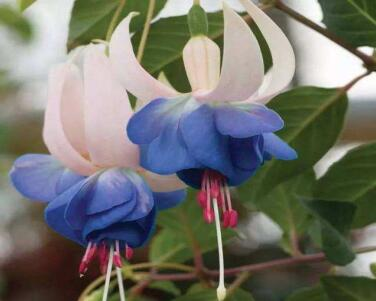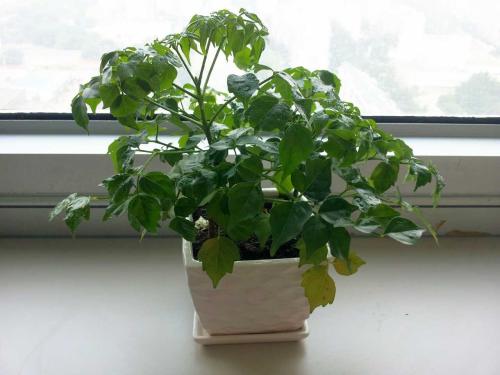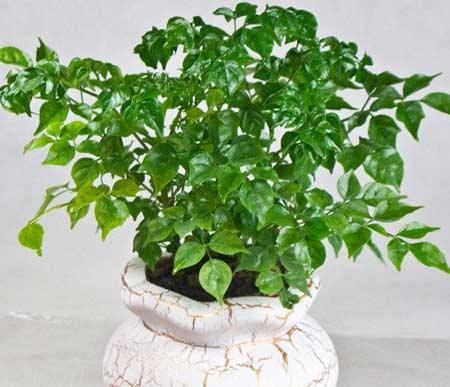Matters needing attention for upside-down Admiralty Bell in Culture
1. Purify the air
Planting inverted Admiralty potted plants indoors can not only decorate the indoor environment and make the indoor become vibrant, but also remove some harmful substances and play a role in purifying indoor air.
2. Medicinal value
Admiralty hanging upside down is a good traditional Chinese medicine, which has a significant effect on the treatment of rheumatoid arthritis and pain caused by injury.

Upside down Admiralty culture methods, upside down Admiralty culture matters needing attention [
Hanging upside down Jinzhong likes wet and cool environment, and it is suitable for fertile and loose micro-acid soil, afraid of high temperature and strong light. Summer should be dry, cool and semi-overcast; winter should be warm, humid, sunny and well ventilated. Hanging together in the shape of golden bell flowers, it is extremely elegant. Potted plants are used to decorate balconies, windowsills, studies, etc., and can also be hung in anti-theft nets, corridor racks and other places for appreciation. The following is to introduce the feeding methods and matters needing attention of hanging Golden Bell upside down.
Culture method of hanging Admiralty upside down
In order to make the leaves of the Admiralty hang upside down and blossom, attention should be paid to:
Upside-down Admiralty Culture: soil selection
The basin soil was mixed with sandy garden soil, humus soil and farm manure. Before entering the growing season every spring, it is necessary to change the pot and soil, remove part of the pot soil, cut off part of the old root, change to a larger flowerpot according to the plant size, and then supplement the prepared pot soil. The soil should be loose, fertile and well drained. If there is stagnant water, the plant is easy to die from rotten roots. The soil should be loosened properly in spring and autumn.
Upside down hanging Admiralty Culture: changing and turning pots
Cuttings survive or the seedlings after sowing have to be changed several times from small to medium to large pots. The plant needs to be turned once before sprouting in spring or autumn every year, and the substrate should be cultured in fertile, loose and well-drained soil. generally, rotten leaf soil can be evenly mixed with rotten organic fertilizer and phosphate fertilizer, and there is no need to apply base fertilizer to avoid rotting roots.
Upside-down Admiralty culture: fertilization
When potted, 4 parts of rotten leaf soil, 3 parts of garden soil, 2 parts of river sand and 1 part of rotten cake fertilizer powder should be mixed into culture soil, and there is no need to apply base fertilizer so as not to cause rotten root. Because of the fast growth and many times of flowering, thin fertilizer should be applied frequently during the growth period, thin cake fertilizer or compound fertilizer should be applied every 10 days, and liquid fertilizer dominated by phosphorus and potassium should be applied once a month during flowering, but fertilizer should be stopped in high temperature season. The basin soil should be dry before fertilization; spray water with a fine sprinkler after fertilization to prevent the leaves from getting fat and water and rot.
Upside down Admiralty culture: temperature
The temperature of upside down hanging Admiralty is 10: 28 ℃, and the temperature in summer can not exceed 30 ℃, so we should do a good job of cooling in summer; in winter, the sun should be sufficient, and the culture temperature should not be lower than 5 ℃, otherwise it will cause frost injury and heat preservation measures must be taken. In addition, we should pay attention to ventilation in both winter and summer.
Upside down Admiralty farming: watering
Watering should be dry and ready-to-use, watering thoroughly, avoid stagnant water. It is better to dry the basin soil in summer, but pay attention to spraying water on the leaf surface and the ground. Long-term wet basin soil can easily lead to rotten roots, yellow leaves, and even cause plant death. When the room temperature is less than 10 ℃ in winter, watering should be strictly controlled and fertilization should be stopped to prevent rotting roots.
Upside-down Admiralty culture: placement
In order to keep the upside-down golden bell plant type plump, the position should be changed frequently during the growing period to make the plant receive light evenly, so as not to deviate to one side and destroy the plant type. But it should be moved less during flowering, otherwise it will cause buds and flowers to fall.
Upside-down Admiralty Culture: heart-picking method
Picking the heart at the right time is an important measure to make the golden bell grow luxuriantly. In spring and autumn, it is necessary to top and pick the heart of the plant, promote its branching, make the plant shape plump, and increase the number of flowers. Coring should start from the seedling stage, generally, when the seedling grows to about 10 cm, the first coring is carried out to promote branching. About 30 days after the first coring, when the new branch grows 6-8 leaves, the second coring is carried out, and 5 or so lateral branches are retained in each plant to remove the excess lateral buds.
The breeding method of hanging Golden Bell upside down
Admiralty hanging upside down is commonly used for cutting and sowing to multiply.
1. Cutting method
Except for the dormant period in summer, it can be carried out all year round, and it is better to cut in spring, and the rooting and survival rate is high and fast. Cuttings select vigorous shoot at the tip, 7-8 cm long, with 2-3 nodes, basal leaves cut off, inserted in the sand bed, often spray to adhere to moisture, 10 days distribution can take root, 1 month later can be potted.
2. Sowing method
It can be carried out in both spring and autumn. In autumn, it can germinate in 15 days at the temperature of 15-20 ℃. The seedlings sown in spring do not bloom until the second year.
Matters needing attention in upside-down Admiralty Culture
1. The upside-down Admiralty grows rapidly and blossoms more, so the supply of fertilizer and water should be strengthened during the growing period. Fertilize once every 10 to 15 days except no fertilizer in hot summer. The Admiralty hung upside down prefers a cold environment, with more than 30% semi-dormant. In summer, the plant should be placed under the shade shed, often spraying water on the leaf surface or sprinkling water to the ground to enhance ventilation. Control watering to make it dormant over the summer.
2. When the temperature drops below 10 ℃ in autumn, it should be moved indoors, the temperature should be controlled within 10-20 ℃, and the management of fertilizer and water should be strengthened. At the same time, pay attention to pruning. Stop coring and pruning about 20 days before the scheduled florescence. If the temperature is controlled properly, it can be opened at that time.
3. The Admiralty clock is afraid of cold. If the temperature is below 5 ℃, there will be frost injury. In winter, the balcony had better be kept above 10 ℃. Can be placed in a closed balcony with light for cultivation to ensure sufficient light. Attention should be paid to the relationship between water and fertilizer supply and temperature in management. If the indoor temperature is above 15 ℃, the flowering plants will blossom continuously. If the temperature is lower than 5 ℃, it will die.
4. The upside-down golden bell grows faster and has the characteristics of continuous flowering, such as insufficient fertilization or dormant fertilization can easily lead to less flowering. Normal fertilization should be applied once every 10-15 days in spring and autumn, and stop applying fertilizer at high temperature in summer. Spray water once after fertilization to avoid liquid fertilizer sticking to the leaves and causing rot.
5. The potted soil should not be too dry and too wet, otherwise it is easy to cause fallen leaves, buds and flowers. Keep the soil moist in spring and autumn and control watering in summer. Watering should also be controlled after coring and heavy shearing, and normal watering should be carried out after the new branches germinate.
Matters needing attention to hang the golden clock upside down for the summer
1. To cool and humidify, family potted plants can move the flowerpot to a cool place with ventilation and shelter from rain, such as on the north balcony or under the eaves where scattered light can be seen slightly, or in a cool and ventilated place where the indoor sun is slightly visible. At the same time, when the temperature is over 25 ℃, spray water on the leaves 1-2 times a day, spray water 3-4 times when the temperature is over 30 ℃, and water the ground around the flowerpot 2-3 times. The following cooling temperature increases the humidity of the air.
2. Fertilizer and water should be controlled. During the high temperature season from July to August, fertilizer should be applied successively and watering should be manipulated. It is appropriate to basin the soil slightly on the dry side.
4. it is necessary to prevent the rain, which will briefly cause rotten roots and fallen leaves.
5. In order to cultivate new seedlings, the perennial plants that hang the golden bell upside down are active to high temperature, while the seedlings have strong heat resistance and do not lose leaves in hot summer, so the annual cutting cultivation of new seedlings is beneficial to their safety in summer, which is a more vivid method.
Culture method of hanging Admiralty upside down matters needing attention in culture of upside down Admiralty
The inverted Golden Bell is very popular with flower friends because it looks like a lantern, but many flower lovers do not know how to raise the inverted Golden Bell. Below I share the planting experience of the inverted Golden Bell and the feedback from the flower friends I know for reference.
The culture method of hanging Admiralty upside down:
1. Soil selection: the basin soil was mixed with sandy garden soil, humus soil and farm manure. Before entering the growing season every spring, it is necessary to change the pot and soil, remove part of the pot soil, cut off part of the old root, change to a larger flowerpot according to the plant size, and then supplement the prepared pot soil. The soil should be loose, fertile and well drained. If there is stagnant water, the plant is easy to die from rotten roots. The soil should be loosened properly in spring and autumn.
2. Watering method: watering should be dry and ready to be watered. Avoid stagnant water. It is better to dry the basin soil in summer, but pay attention to spraying water on the leaf surface and the ground.
3. Fertilization method: because the golden bell grows fast and blossoms many times, thin fertilizer should be applied frequently during the growth period, thin cake fertilizer or compound fertilizer should be applied every 10 days, and liquid fertilizer dominated by phosphorus and potassium should be applied once a month during flowering, but fertilizer should be stopped in high temperature season. The basin soil should be dry before fertilization; spray water with a fine sprinkler after fertilization to prevent the leaves from getting fat and water and rot.
4, temperature requirements: the growth temperature of the Admiralty clock upside down is 10: 28 ℃, and the temperature in summer can not exceed 30 ℃, so the cooling work should be done well in summer; sufficient sunshine is required in winter, and the culture temperature should not be lower than 5 ℃, otherwise it will cause frost injury and heat preservation measures must be taken. In addition, we should pay attention to ventilation in both winter and summer.
5. Pest control: in indoor cultivation, if poor ventilation, young stems and leaves are easy to suffer from aphids and whitefly. When it occurs, the 200-fold liquid of omethoate can be used to spray and control.
Points for attention in culture of hanging Admiralty upside down:
1. The upside-down Admiralty grows rapidly and blossoms more, so the supply of fertilizer and water should be strengthened during the growing period. Fertilize once every 10 to 15 days except no fertilizer in hot summer. The Admiralty hung upside down prefers a cold environment, with more than 30% semi-dormant. In summer, the plant should be placed under the shade shed, often spraying water on the leaf surface or sprinkling water to the ground to enhance ventilation. Control watering to make it dormant over the summer.
2. When the temperature drops below 10 ℃ in autumn, it should be moved indoors, the temperature should be controlled within 10-20 ℃, and the management of fertilizer and water should be strengthened. At the same time, pay attention to pruning. Stop coring and pruning about 20 days before the scheduled florescence. If the temperature is controlled properly, it can be opened at that time.
3. The Admiralty clock is afraid of cold. If the temperature is below 5 ℃, there will be frost injury. In winter, the balcony had better be kept above 10 ℃. Can be placed in a closed balcony with light for cultivation to ensure sufficient light. Attention should be paid to the relationship between water and fertilizer supply and temperature in management. If the indoor temperature is above 15 ℃, the flowering plants will blossom continuously. If the temperature is lower than 5 ℃, it will die.
4. The upside-down golden bell grows faster and has the characteristics of continuous flowering, such as insufficient fertilization or dormant fertilization can easily lead to less flowering. Normal fertilization should be applied once every 10-15 days in spring and autumn, and stop applying fertilizer at high temperature in summer. Spray water once after fertilization to avoid liquid fertilizer sticking on the leaves and causing rot.
5. The potted soil should not be too dry and too wet, otherwise it is easy to cause fallen leaves, buds and flowers. Keep the soil moist in spring and autumn and control watering in summer. Watering should also be controlled after coring and heavy shearing, and normal watering should be carried out after the new branches germinate.
The above is the relevant introduction of this article, I believe you have a simple understanding of this after reading it, if necessary, you can continue to pay attention to the No. 1 home network to learn more information.
- Prev

The breeding mode of happiness tree
1. Cuttings take the qualitative branches of Happy trees, cut all the leaves, insert them into the soil, and then take good care of them every day until they take root. 2. the strip cuts the branch near the ground, then presses it into the soil, and finally, after the cut grows out of the root system.
- Next

Maintenance methods and matters needing attention of Happiness Tree
1, the temperature happiness tree sex likes the warm hot environment, the growth most suitable temperature is 20 degrees to 30 degrees, so usually should pay attention to the temperature control. 2. Light Happiness trees like plenty of light, of course, they should pay attention to moderate light in summer, preferably on the balcony or windowsill
Related
- Fuxing push coffee new agricultural production and marketing class: lack of small-scale processing plants
- Jujube rice field leisure farm deep ploughing Yilan for five years to create a space for organic food and play
- Nongyu Farm-A trial of organic papaya for brave women with advanced technology
- Four points for attention in the prevention and control of diseases and insect pests of edible fungi
- How to add nutrient solution to Edible Fungi
- Is there any good way to control edible fungus mites?
- Open Inoculation Technology of Edible Fungi
- Is there any clever way to use fertilizer for edible fungus in winter?
- What agents are used to kill the pathogens of edible fungi in the mushroom shed?
- Rapid drying of Edible Fungi

